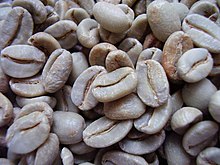Trigonelline
| Structural formula | ||||||||||
|---|---|---|---|---|---|---|---|---|---|---|

|
||||||||||
| General | ||||||||||
| Surname | Trigonelline | |||||||||
| other names |
|
|||||||||
| Molecular formula | C 7 H 7 NO 2 | |||||||||
| Brief description |
colorless solid (hydrochloride) |
|||||||||
| External identifiers / databases | ||||||||||
|
||||||||||
| properties | ||||||||||
| Molar mass | 137.13 g mol −1 | |||||||||
| Physical state |
firmly |
|||||||||
| Melting point |
|
|||||||||
| solubility |
|
|||||||||
| safety instructions | ||||||||||
|
||||||||||
| As far as possible and customary, SI units are used. Unless otherwise noted, the data given apply to standard conditions . | ||||||||||
Trigonelline , nicotinic acid - N -methyl betaine , is an alkaloid from the trigonelline group and an N -methyl derivative of nicotinic acid. It occurs in coffee beans in amounts between 0.3 and 1.3%, but is subject to greater changes when roasting the coffee beans, in contrast to caffeine . It can either be demethylated to nicotinic acid or decarboxylated to N -methylpyridinium .
Occurrence
In addition to the content in coffee beans, trigonelline is contained as a base in the seeds of many plants, such as Trigonella foenumgraecum , Strophanthus spp , in poison plants and in hemp , fennel and legumes .
presentation
The synthesis of trigonelline can be carried out by heating nicotinic acid with iodomethane and treating it with silver (I) oxide .
Use
During the roasting of coffee, the vitamin B 3 ( nicotinic acid ), which is important for humans, is formed from trigonelline .

This means that a cup of coffee can cover around 10% of the daily requirement for this vitamin, as it remains dissolved in the lipid droplets during coffee preparation.
Trigonellin in seeds of Arabica coffee contains about one percent. The content changes due to the roasting process of the coffee:
| variety | raw | roasted |
|---|---|---|
| Arabica | 1.0-1.2 | 0.5-1.0 |
| Robusta | 0.6-0.75 | 0.3-0.6 |
A 150 ml cup from 7.5 g of roasted coffee contains an average of 27 mg of trigonelline, although this is decisively influenced by the infusion method.
A patent application has been filed for the use of trigonelline to promote hair growth, with fenugreek seeds containing 3% trigonelline being used as the starting substance. The mechanism of action on the hair roots is not exactly known, it is assumed that trigonellin and diosgenin act against the hair-damaging dihydrotestosterone and prevent its formation, whereby the hair roots are protected.
Scientists from the University of Ancona found in a study that the ingredients of coffee can protect against dental caries . Tooth decay is caused by the action of various bacteria that settle in mucus and plaque on the tooth surface. More detailed investigations are still necessary, components of coffee that have so far been little studied, such as trigonelline and nicotinic acid, seem to inhibit bacterial growth.
literature
- A. Heiduschka, R. Brüchner: About the occurrence of trigonelline in Guatemala coffee . In: Journal for Practical Chemistry . tape 130 , no. 1 , 1931, p. 11-22 , doi : 10.1002 / prac.19311300102 .
- D. Ackermann, PH List: About the occurrence of trimethylamine oxide, homarin, trigonelline and a base C 4 H 9 O 2 N in the crab (Crangon vulgaris) . In: Hoppe-Seyler's journal for physiological chemistry . tape 306 , January 1957, p. 260-264 , doi : 10.1515 / bchm2.1957.306.1-2.260 .
Web links
- Dagmar Schecklmann, Matthias Ritter: Coffee from the chemist's point of view . University of Bayreuth, SS 1996 and SS 1997.
- Tobias Flassig, Katharina Kleiber: Chemical aspects of coffee . University of Bayreuth (Lecture by Tobias Flassig (SS 2000) and Katharina Kleiber (SS 2009) as part of the "Exercises in Lecturing with Demonstrations - Organic Chemistry").
- Trigonelline and roasting products . University of Bayreuth.
Individual evidence
- ↑ a b c data sheet Trigonelline hydrochloride from Sigma-Aldrich , accessed on May 21, 2017 ( PDF ).
- ↑ a b c d e Entry on Trigonelline. In: Römpp Online . Georg Thieme Verlag, accessed on November 4, 2013.
- ↑ a b Merck Index , 11th Edition, 9606.
- ^ Entry on Trigonelline in the Hazardous Substances Data Bank , accessed on November 18, 2014.
- ^ Richard H. Stadler, Natalia Varga, Jörg Hau, Francia Arce Vera and Dieter H. Welti (2002): Alkylpyridiniums. 1. Formation in Model Systems via Thermal Degradation of Trigonelline . J. Agric. Food Chem. , 50 (5), 1192-1199, doi: 10.1021 / jf011234k .
- ↑ Casal, S. et al. (2000): Discriminate analysis of roasted coffee varieties for trigonelline, nicotinic acid, and caffeine content . In: J Agric Food Chem 48 (8); 3420-3424; PMID 10956127 ; doi: 10.1021 / jf990702b .
- ↑ Klaus Roth: Espresso: A three-step preparation . In: GIT Labor-Fachzeitschrift Heft 8, 2013, p. 486ff.
- ^ Phytochemistry: Coffee.
- ↑ Changes in the proportion of ingredients due to the roasting process. ( Memento of the original from October 29, 2013 in the Internet Archive ) Info: The archive link was inserted automatically and has not yet been checked. Please check the original and archive link according to the instructions and then remove this notice.
- ↑ Use of trigonelline for the production of a perorally ingested encapsulated agent for revitalization and for stimulating and strengthening hair growth in living beings.
- ↑ Federal Court of Justice 177-98 (PDF; 65 kB), March 20, 2001.
- ↑ bleibjung.de: Eating and drinking healthily: Tea and coffee protect stomach and teeth ( Memento of the original from June 18, 2015 in the Internet Archive ) Info: The archive link was automatically inserted and not yet checked. Please check the original and archive link according to the instructions and then remove this notice. , accessed September 16, 2013.

